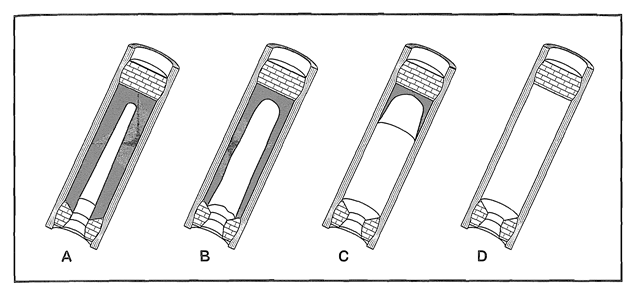The most common grain geometry has a hollow bore hole, or core, running right up the center of the propellant grain. In its simplest form, the core is shaped like a slightly tapered cylinder. Figure 2-4 is a cutaway drawing of one of these motors. It’s called a cylindrical core burner, and Figure 2-5 shows what happens when it burns. Ignition starts at the core’s forward end. and instantly spreads to the rear, lighting the length of the core as it goes. From that point on the flame spreads outward in the shape of an expanding cylinder, consuming the last of the propellant as it reaches the inside of the casing wall. In motors with small nozzles and short cores, the chamber pressure and thrust start out low and reach their maximums at burnout. In motors with larger nozzles and longer cores the initial values are higher. In motors with very large nozzles and very long cores the starting pressure and starting thrust can exceed 50% of their maximums.

Figure 2-5. The flame in a cylindrical core burner spreads outward in the form of an expanding cylinder. The ongoing increase in the amount of propellant burning at any moment causes a steady increase in chamber pressure and thrust as the burn proceeds.
A motor’s core length is the length of the propellant grain’s bore hole, as measured from the boundary between the nozzle clay and where the propellant begins, to where the hole terminates at the front of the motor. A motor’s core length is critical because it directly controls the amount of propellant burning at any given moment. If the core is too short, the motor performs poorly. If the core is too long, the maximum chamber pressure can exceed the motor’s design limits, and cause the motor to explode.
Because the burning surface in a core burner is larger than the burning surface in an end burner, a core burner requires a slower burning propellant. Because the distance that the flame travels is short (from the edge of the core to the inside of the casing wall), small core burners have comparatively short burn times. All core burners have the advantage that the layer of unburned propellant between the flame and the casing wall insulates the casing from the heat of the flame until the final moments of the burn.
Figures 2-6.2-7. and 2-8 are examples of the thrust-time curves of an end burner, a short cylindrical core burner, and a long cylindrical cure burner. In each illustration the points A through D correspond to examples A through D in Figures 2-3 and 2-5. The rocket industry uses dozens of other grain geometries, but the building techniques described in this topic will limit you to these three.
Cylindrical Core Burners (Rocket Motor)
Next post: Time Delays (Rocket Motor)
Previous post: End Burners (Rocket Motor)
